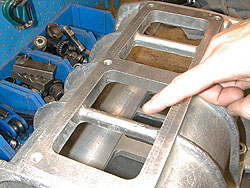805moparkid
Slant and AFX Guy
i have not found a single thread other than this post that breaks down the visable differences between a 6-71 Small Case/Bore, 6v-71, and a 6-71 Large Case/Bore.
The small bore 6 has 3 reinforcement cross bars on the inlet side, and tops of all of them are machined.
(no pic)
The stock Gimmie 6 big bore case has has 3 ribs also, but only the center one has the top of it machine.

After market cases don't have the outer cross braces and sometimes the blower builders will remove the outer ones from stock Gimmie, but all stock GM manufactured cases had the 3 bars because the blowers are mounted on their sides when they are used on a Gimmie diesel.

anything to add?
The small bore 6 has 3 reinforcement cross bars on the inlet side, and tops of all of them are machined.
(no pic)
The stock Gimmie 6 big bore case has has 3 ribs also, but only the center one has the top of it machine.

After market cases don't have the outer cross braces and sometimes the blower builders will remove the outer ones from stock Gimmie, but all stock GM manufactured cases had the 3 bars because the blowers are mounted on their sides when they are used on a Gimmie diesel.
anything to add?
















